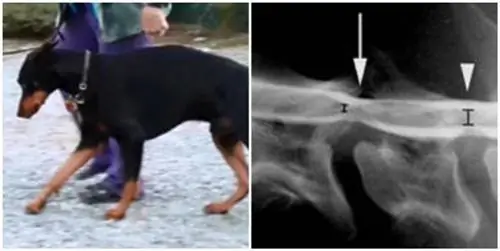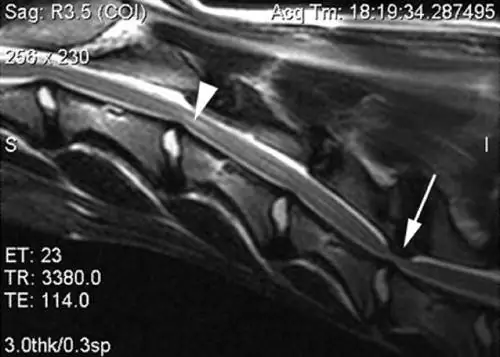- Author Carl Johnson [email protected].
- Public 2023-12-16 06:19.
- Last modified 2025-06-01 05:50.

Wobbler syndrome in dogs, better known as "wobbler syndrome", is a severe degenerative pathology that affects the vertebrae and intervertebral discs of the cervical spine, mainly affecting large or giant dogs.
The progression of this disease usually causes neurological and motor damage, which needs immediate attention so as not to be irreversible. Therefore, early diagnosis is crucial to provide efficient treatment that offers a better quality of life to the animal. And to know the symptoms, causes and treatment of Wobbler syndrome in dogs, our site invites you to continue reading this new article.
What is Wobbler Syndrome or wobble syndrome?
Wobbler syndrome is a cervical spondylomyelopathy (CSM), which includes different chronic degenerative disorders. The pathology develops from excessive compression of both the spinal cord and the nerves located in the neck.
Its progress is silent and its first symptoms are not very specific and difficult to recognize early in dogs, such as neck pain or headaches. This explains why most dogs enter the veterinary clinic with more advanced complications, such as wobbly walk or loss of balanceIn addition, it reaffirms the need to provide adequate preventive medicine to our pets, which allows not only to maintain their good he alth, but also to diagnose any imbalance in their body early

Wobbler syndrome in dogs: possible causes
Currently, the causes of Wobbler syndrome in dogs are still unknown. However, it is recognized that myelopathy pictures derive from the narrowing of the vertebral canal, which is the bony canal that surrounds and protects the soft spinal cord. This narrowing can be caused either by slipping of the intervertebral disc, or by a bone malformation
Keeping in mind that about 50% of Wobbler syndrome cases were diagnosed in Doberman, Great Dane, and Mastiff-type dogs, inheritance genetics appears as a key factor for the development of these degenerative disorders. And genetic predisposition was also observed in the Basset Hound, Rottweiler and Irish Wolfhound.
In addition, around 70% of cases of diagnosed cervical myelopathy, large dogs with accelerated growth are observed, risk factorsfor lurch syndrome. However, it should be noted that some small breeds, such as the Yorkshire, Chihuahua and Pinsher, are also breeds susceptible to Wobble Syndrome.
In more rare cases, the dog may develop a malformation of the cervical region or suffer displacement of the intervertebral discs as a result of some trauma severe to the neck.
Symptoms of wobble syndrome in dogs
As we mentioned earlier, the first symptoms of staggering syndrome can be general and homogeneous, such as pain and stiffness in the neck, which can cause frequent headaches. As the disease progresses, we will observe the appearance of new symptoms.
The symptoms of Wobbler syndrome in dogs are:
- Wobbly moves
- Short and cautious steps
- Cervical stiffness ("stiff neck")
- Frequent loss of balance, causing falls and bumps
- Difficulty moving and getting up
- Progressive loss of muscle mass in the front legs and shoulders
- Constant weakness and tiredness
- Swollen front and hind legs
- Complete or partial paralysis
In more advanced cases, when treatment is started late, the animal is very vulnerable to irreversible neurological deficit and disability.

Diagnosis of Wobbler Syndrome in Dogs
The veterinarian will require the appropriate imaging studies, such as X-rays, magnetic resonance imaging, computed tomography or myelography, to proceed with the Differential diagnosis of Wobbler's syndrome, from the observation of the cervical and spinal vertebrae. You will probably also take into consideration the genetic profile of each dog. In addition, you can request complete blood and urine tests, to also rule out other possible pathological causes and find out your best friend's immune system.
It is essential to reaffirm that the veterinarian is the only professional qualified to correctly diagnose and provide the appropriate treatment to our pets. Therefore, when observing any change in your dog's behavior or habits, do not hesitate to consult the veterinarian you trust immediately. An early diagnosis can save the lives of our furry loved ones.
Treatment of Wobbler syndrome in dogs
The truly effective treatment for Wobbler's syndrome in dogs is a surgical intervention which relieves pressure on the soft medulla of the cervical region. However, this option is not usually viable for older dogs or those with a very weakened he alth condition. In these cases, surgery can worsen neurological damage or cause the death of the animal.
Once again, the veterinarian, with her training and experience, will be able to analyze the he alth and physical condition of each dog to decide whether surgical intervention is an alternative or a risk. Dogs that undergo cervical surgery will need to respect a rest period of 2 to 3 months Ideally, they should be observed during their recovery, to avoid bumps, falls or inappropriate movements, and that they remain on soft and comfortable surfaces, such as mattresses or pillows. In addition, physical therapy of will be essential to prevent atrophy and loss of muscle mass, as well as to speed up the animal's rehabilitation.
If the dog cannot be exposed to surgery, the veterinarian may indicate a outpatient and palliative treatment to relieve pain, provide a better quality of life and comfort to the animal. Alternative and non-invasive therapies may also be applied to provide a pleasant sensation of well-being to the animal, such as massages or aromatherapy. Or simply offer him caresses so that he relaxes and can rest more peacefully.
Wobbler syndrome in dogs, can it be prevented?
As the specific causes of Wobbler syndrome are unknown, it is difficult to speak of exact preventive measures. We are not capable of intervening or changing the genetic heritage of our pets, but we can contribute to strengthening their immune system and improving their physical resistance.
How? Providing a balanced diet, exercising regularly, and offering adequate preventive medicine throughout their lives, which necessarily includes respecting their vaccination and deworming schedule, and having the guidance of a veterinarian you trust.






